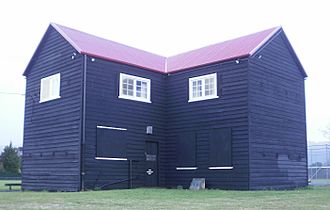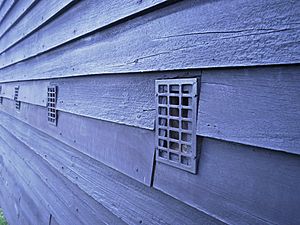Upper Hutt Blockhouse facts for kids
Quick facts for kids Upper Hutt Blockhouse |
|
|---|---|
 |
|
| Former names | Upper Hutt Stockade or Government Stockade |
| Alternative names | Wallaceville Blockhouse |
| General information | |
| Type | Blockhouse, fort |
| Address | Blockhouse Lane, off McHardie Street |
| Town or city | Upper Hutt |
| Country | New Zealand |
| Completed | 1860 |
| Renovated | 1927-28 |
| Technical details | |
| Structural system | Timber framed, shingle infill |
| Floor count | 2 |
| Design and construction | |
| Architect | Col. Thomas Rawlings Mould |
| Architecture firm | Royal Engineers |
| Main contractor | W Taylor |
| Designations | Category 1 Historic Place |
The Upper Hutt Blockhouse, also called the Wallaceville Blockhouse, is an old military building from the 1800s. It's located in Upper Hutt, New Zealand. This type of building, known as a blockhouse, was used for defense.
It's one of the few blockhouses ever built in New Zealand. Today, it's a very important historic site. The blockhouse was built in late 1860. It was part of a larger defensive area called a Stockade. From December 1860 to May 1861, soldiers from the Hutt Battalion used it. Luckily, it was never attacked.
The blockhouse was first built in a field. Now, you can find it at the end of Blockhouse Lane. This is near the sports fields of Heretaunga College.
Contents
Why Was the Blockhouse Built?
In 1860, there was tension with some Māori people in the Ōtaki area. Settlers also worried about attacks from Māori in Wairarapa. Because of these fears, people asked for a safe place to go. A land dispute in Taranaki also made people more worried.
In July 1860, settlers in Upper Hutt formed a group called the Volunteer Rifle Corps. They asked the Wellington Militia to build a stockade in Upper Hutt. A stockade is a strong fence or barrier for defense.
How the Blockhouse Was Built
The blockhouse was designed by Colonel Thomas Rawlings Mould. It was built towards the end of 1860. On August 18, 1860, Major W. Rawson Trafford announced the plans. He was in charge of the Wellington Militia.
The plans were for a Stockade and Blockhouse in Upper Hutt. A man named W. Taylor won the bid to build it. He had also built a similar blockhouse in Lower Hutt.
The building has two floors. Its frame is made of timber. The walls are double-layered with shingle in between. This design helped protect it from rifle fire. Small openings called loopholes were also built. These allowed defenders to shoot back safely.
The blockhouse stood in one corner of a larger stockade. The stockade had earth walls, a trench, a well, and a place to store ammunition. The earth walls of the stockade were removed later. This happened when Heretaunga College was built in 1954.
The blockhouse was never officially used as a refuge. However, some stories say families hid there one night. This happened in the late 1880s or early 1890s during an emergency.
Over the years, the blockhouse has been changed a bit. It didn't have windows at first. Now, it has some windows. Modern additions include electricity, security lights, and a sprinkler system. Metal grates were added over the loopholes. The building has also been restored. It now has a black wood stain and a red roof. This looks similar to how it did in the 1860s.
What Was the Blockhouse Used For?
Soldiers from the Hutt Battalion used the blockhouse. They were there from December 1860 to May 1861. A memorial plaque says there were no battles during this time.
After the soldiers left, the building was used for other things. From 1861 to 1880, the Police used it. It was a police station, a home for the officer, and even a courthouse.
After 1880, the blockhouse was sometimes used as a public building. In 1884, the local School Committee wanted to rent the land. In 1891, the police moved to a new station. The blockhouse was then left empty for many years.
The Blockhouse in the 1900s
Local people cared about saving the blockhouse. In 1916, the land around it became a protected area. This was one of the first times a historic building in New Zealand was legally protected.
In 1927-28, the building was repaired a lot. More windows were added. In the 1950s, a group was formed to restore the blockhouse. It was restored around 1954.
From 1953 to the late 1990s, Boy Scouts and Girl Guides used the building. A local club also held meetings there.
In 1980, the blockhouse and its land became an historic reserve. Soon after, the New Zealand Historic Places Trust started looking after the building. The building was changed again around 1989.


